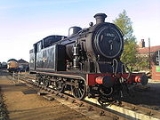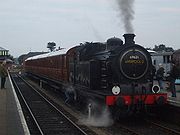
GER Class L77
Encyclopedia
The GER Class L77, LNER
Class N7, is a class of 0-6-2T steam locomotives. They were designed by Alfred John Hill
of the Great Eastern Railway
and introduced in 1915. The design was perpetuated by Nigel Gresley
of the LNER after the 1923 grouping
. 134 were built; only one of them is preserved.
s and piston valves. They were unusual (for inside-cylinder locomotives) in having Walschaerts valve gear. They were, as London suburban locomotives, fitted with Westinghouse
air brakes.
Some were fitted with condensing apparatus
for working on the Metropolitan Line
and the East London Line
but the condensing apparatus was removed between 1935 and 1938.
. The LNER added 7000 to their GER numbers, and then built a further 112 locomotives between 1925 and 1928. In the 1946 renumbering scheme, they were renumbered 9600–9733, and upon nationalisation in 1948, British Railways added 60000 to their number (69600–69733).
 One, No. 7999 (BR No. 69621) has been preserved and is currently operational (Having had work done on the centre axle boxes). It is owned by the East Anglian Railway Museum
One, No. 7999 (BR No. 69621) has been preserved and is currently operational (Having had work done on the centre axle boxes). It is owned by the East Anglian Railway Museum
. It was the last engine built by the Great Eastern Railway's Stratford Works
in 1924 and was preserved in 1962. It was also named in honour of its designer A J Hill in 1989.
London and North Eastern Railway
The London and North Eastern Railway was the second-largest of the "Big Four" railway companies created by the Railways Act 1921 in Britain...
Class N7, is a class of 0-6-2T steam locomotives. They were designed by Alfred John Hill
Alfred John Hill
Alfred John Hill was Chief Mechanical Engineer at the Stratford Works of the Great Eastern Railway from 1912-1922.His best-known design is probably the GER Class L77 0-6-2 tank locomotive which was perpetuated by Nigel Gresley of the London and North Eastern Railway after the 1923...
of the Great Eastern Railway
Great Eastern Railway
The Great Eastern Railway was a pre-grouping British railway company, whose main line linked London Liverpool Street to Norwich and which had other lines through East Anglia...
and introduced in 1915. The design was perpetuated by Nigel Gresley
Nigel Gresley
Sir Herbert Nigel Gresley was one of Britain's most famous steam locomotive engineers, who rose to become Chief Mechanical Engineer of the London and North Eastern Railway . He was the designer of some of the most famous steam locomotives in Britain, including the LNER Class A1 and LNER Class A4...
of the LNER after the 1923 grouping
Railways Act 1921
The Railways Act 1921, also known as the Grouping Act, was an enactment by the British government of David Lloyd George intended to stem the losses being made by many of the country's 120 railway companies, move the railways away from internal competition, and to retain some of the benefits which...
. 134 were built; only one of them is preserved.
Overview
The N7s had superheaterSuperheater
A superheater is a device used to convert saturated steam or wet steam into dry steam used for power generation or processes. There are three types of superheaters namely: radiant, convection, and separately fired...
s and piston valves. They were unusual (for inside-cylinder locomotives) in having Walschaerts valve gear. They were, as London suburban locomotives, fitted with Westinghouse
Westinghouse Air Brake Company
The railway air brake was invented by George Westinghouse of New York state in 1869. Soon after, he moved to Pittsburgh, Pennsylvania, where he established the Westinghouse Air Brake Company on September 28, 1869...
air brakes.
Some were fitted with condensing apparatus
Steam locomotive condensing apparatus
A steam locomotive condensing apparatus differs in purpose from the usual closed cycle steam engine condenser, in that its function is primarily either to recover water, or to avoid excessive emissions to the atmosphere, rather than maintaining a vacuum to improve both efficiency and power...
for working on the Metropolitan Line
Metropolitan Line
The Metropolitan line is part of the London Underground. It is coloured in Transport for London's Corporate Magenta on the Tube map and in other branding. It was the first underground railway in the world, opening as the Metropolitan Railway on 10 January 1863...
and the East London Line
East London Line
The East London Line is a London Overground line which runs north to south through the East End, Docklands and South areas of London.Built in 1869 by the East London Railway Company, which reused the Thames Tunnel, originally intended for horse-drawn carriages, the line became part of the London...
but the condensing apparatus was removed between 1935 and 1938.
Numbering
The first 22 were allocated numbers in the 990–1011 range when ordered by the GER, but the last 10 did not emerge until the groupingRailways Act 1921
The Railways Act 1921, also known as the Grouping Act, was an enactment by the British government of David Lloyd George intended to stem the losses being made by many of the country's 120 railway companies, move the railways away from internal competition, and to retain some of the benefits which...
. The LNER added 7000 to their GER numbers, and then built a further 112 locomotives between 1925 and 1928. In the 1946 renumbering scheme, they were renumbered 9600–9733, and upon nationalisation in 1948, British Railways added 60000 to their number (69600–69733).
| Year | Order | Manufacturer | Quantity | GER Nos. | LNER Nos. | 1946 Nos. | Notes |
|---|---|---|---|---|---|---|---|
| 1915 | L77 | Stratford Works | 2 | 1000–1001 | 8000–8001 | 9600–9601 | Renumbered 7978–7979 in 1944 |
| 1921 | K85 | Stratford Works | 10 | 1002–1011 | 8002–8001 | 9602–9611 | Renumbered 7980–7989 in 1944 |
| 1923–24 | K89 | Stratford Works | 10 | (990–999) | 7990–7999 | 9612–9621 | |
| 1925–26 | — | Gorton Works | 30 | — | 409, 421, 426, 457, 457, 460, 464, 471, 473, 475, 826–830, 832–834, 837, 838, 850–853, 865–868, 870, 873 | 9622–9651 | Class N7/1 |
| 1925–26 | — | Robert Stephenson & Co. | 20 | — | 907, 912, 913, 916, 918, 919, 935, 940, 941, 947, 950, 952, 964, 966–968, 970, -971, 979, 979 | 9652–9671 | Class N7/1 |
| 1927–28 | — | Gorton Works | 10 | — | 2632–2641 | 9672–9681 | Class N7/2 |
| 1927 | — | Wm. Beardmore & Co. | 20 | — | 2642–2661 | 9682–9701 | Class N7/2 |
| 1927–28 | — | Doncaster Works | 32 | — | 2600–2631 | 9702–9733 | Class N7/3 |
Sub-classes
- N7 Introduced 1914, GER Class L77 with Belpaire fireboxBelpaire fireboxThe Belpaire firebox is a type of firebox used on steam locomotives. It was invented by Alfred Belpaire of Belgium. It has a greater surface area at the top of the firebox, improving heat transfer and steam production...
- N7/1 Introduced 1925, LNER development of GER design with Belpaire firebox
- N7/2 Introduced 1926, LNER locos with Belpaire firebox and long-travel valves
- N7/3(1)Introduced 1927, LNER locos with round-top fireboxRound-topped boilerA round-topped boiler is a type of boiler used for some designs of steam locomotive and portable engine. It was an early form of locomotive boiler, although continuing to be used for new locomotives through to the end of steam locomotive manufacture in the 1960s.They use the early form of firebox,...
- N7/3(2)Introduced 1943, rebuild of N7/1 with round-top firebox
- N7/3(3)Introduced 1943, rebuild of N7/2 with round-top firebox
- N7/4 Introduced 1940, GER locos rebuilt with round-top firebox
Preservation

East Anglian Railway Museum
The East Anglian Railway Museum is located at Chappel and Wakes Colne railway station in Essex, which is situated on the former Great Eastern Railway branch line from Marks Tey to Sudbury...
. It was the last engine built by the Great Eastern Railway's Stratford Works
Stratford Works
Stratford Works was the locomotive-building works of the Great Eastern Railway situated at Stratford, London, England. It was opened in 1847-1848 by the GER's predecessor, the Eastern Counties Railway...
in 1924 and was preserved in 1962. It was also named in honour of its designer A J Hill in 1989.
Reference
- Ian Allan ABC of British Railways Locomotives, 1948 edition, part 4, pp 54–55

